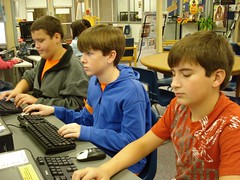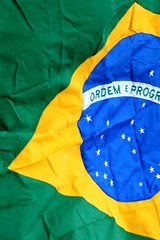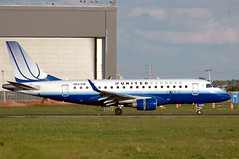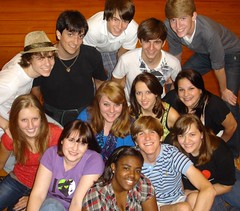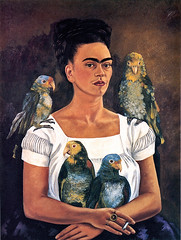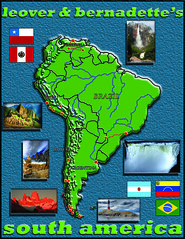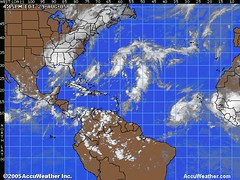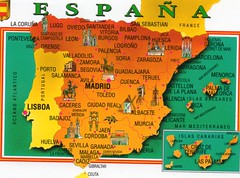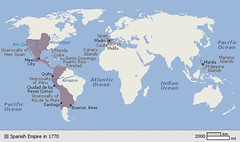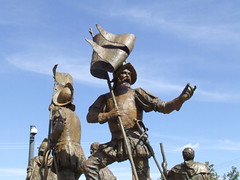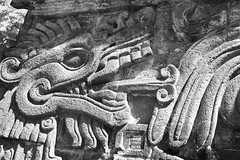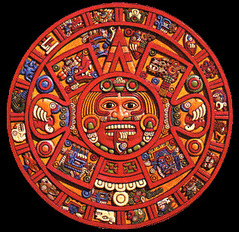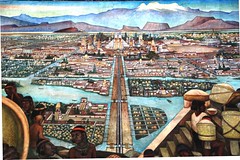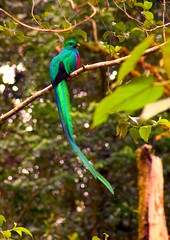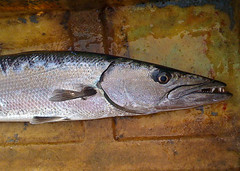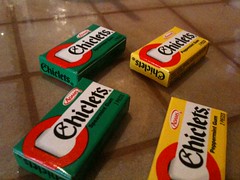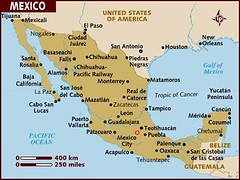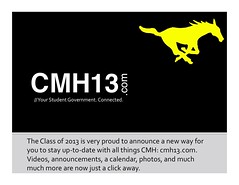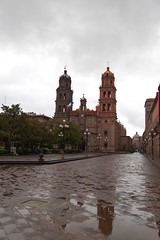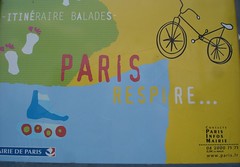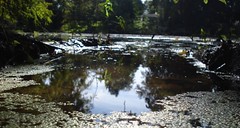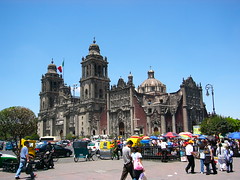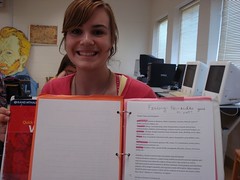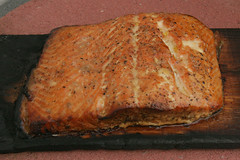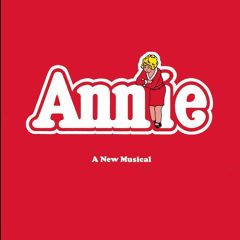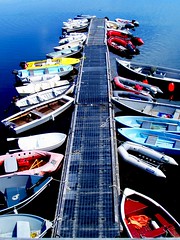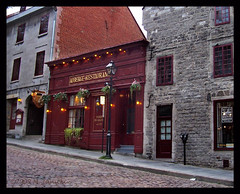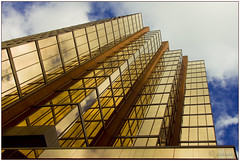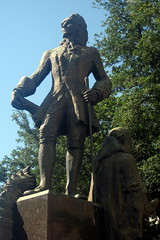From Ktbs.com:
Caddo Parish and Bossier Parish schools will not have classes on Friday because of the effects from Thursday's storms, officials from each school district said.
Bossier Parish Community College has also canceled classes.
Friday, October 30, 2009
Thursday, October 29, 2009
The movie "Master and Commander; Far Side of the World" is a historic story of 19th century sailors on the coast of Brazil
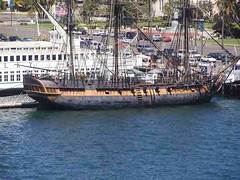
The HMS Surprise from the movie, "Master and Commander; Far Side of the World"
Originally uploaded by BillGraf
Nearly all of the film takes place aboard the HMS Surprise, under the command of Captain "Lucky" Jack Aubrey (Russell Crowe).
The captain's orders: to intercept and disable the French privateer Acheron, which is troubling British vessels off the coast of South America. The two ships clash early on, and the Surprise is thoroughly routed--the Acheron is larger, faster, and more modern. But Aubrey, with a determination that might not entirely be due to his sense of duty, is not one to give up, and the Surprise chases the Acheron--and/or vice versa--down the Brazilian coast, around Cape Horn, and to the Gallapagos Islands.
Highly recommended. PG-13 for battle gore.
Brazil: Portuguese-speaking, multi-ethnic land of amazing biodiversity
Basic national background from Wikipedia.com -
- the largest country in South America and the only Portuguese-speaking country on that continent.
- Brazil was a colony of Portugal from the landing of Pedro Álvares Cabral in 1500 until its independence in 1822.
- Brazil is the world's eighth largest economy at market exchange rates[3] and the ninth largest by purchasing power parity.[15] Economic reforms have given the country new international recognition.
- It is a democracy.
- A predominantly Roman Catholic, Portuguese-speaking, and multiethnic society.
- The most accepted etymology of the name Brazil is that it was named after the tree brazilwood[17] which in Portuguese is pau-brasil, and the word brasil is commonly defined by the dictionaries of different languages as the color of red like ember, formed by the word brasa (ember).
- Brazil is the fifth largest country in the world—after Russia, Canada, China and the United States.
- The climate of Brazil comprises a wide range of weather conditions across a large geographic scale and varied topography, but the largest part of the country is tropical.
- The Macaw is a typical animal of Brazil. The country has one of the world's most diverse populations of birds and amphibians.
- Brazil's large territory comprises different ecosystems, such as the Amazon Rainforest, recognized as having the greatest biological diversity in the world;[33] the Atlantic Forest and the Cerrado, which together sustain some of the world's greatest biodiversity.
- Scientists estimate that the total number of plant and animal species in Brazil could approach four million.[34] Larger mammals include pumas, jaguars, ocelots, rare bush dogs, and foxes. Peccaries, tapirs, anteaters, sloths, opossums, and armadillos are abundant. Deer are plentiful in the south, and monkeys of many species abound in the northern rain forests.[34][36] Concern for the environment in Brazil has grown in response to global interest in environmental issues.
- Its natural heritage is extremely threatened by cattle ranching and agriculture, logging, mining, resettlement, oil and gas extraction, over-fishing, expansion of urban centres, wildlife trade, fire, climate change, dams and infrastructure, water contamination, and invasive species.[33] In many areas of the country, the natural environment is threatened by development.
- Brazilians are very strong in agricultural, mining, manufacturing and service sectors, as well as a large labor pool.[15] Brazilian exports are booming, creating a new generation of tycoons.[192] Major export products include aircraft, coffee, automobiles, soybean, iron ore, orange juice, steel, ethanol, textiles, footwear, corned beef and electrical equipment.
- Industry is highly concentrated geographically, with the leading concentrations in metropolitan São Paulo, Rio de Janeiro, Campinas, Porto Alegre, and Belo Horizonte. Technologically advanced industries are also highly concentrated in these locations.
- Brazil is expected to become a major oil producer and exporter, having recently made huge oil discoveries.
- 49.4% of the population self-declared White, about 93 million; 42.3% self-declared Pardo (brown), about 80 million; 7.4% self-declared Black, about 13 million; 0.5% self-declared Asian, about 1 million; and 0.4% self-declared Amerindian, about 519,000.
- Over three centuries of Portuguese colonization, Brazil received more than 700,000 Portuguese settlers and 4 million African slaves.[228] The country has the largest population of African descent outside of Africa.
- The largest metropolitan areas in Brazil are São Paulo, Rio de Janeiro, and Belo Horizonte, with 19.7, 11.4, and 5.4 million inhabitants respectively.
- Brazilian Portuguese has had its own development, influenced by the Amerindian and African languages.[249] Due to this, the language is somewhat different from that spoken in Portugal and other Portuguese-speaking countries, mainly for phonological and orthographic differences. These differences are somewhat greater than those of American and British English.
- The festival of Carnival (Portuguese: Carnaval), with its spectacular street parades and vibrant music, has become one of the most potent images of Brazil;[254] an annual celebration held forty days before Easter and marks the beginning of Lent.
- Brazil's cultural tradition extends to its music styles which include samba, bossa nova, forró, frevo, pagode and many others.
- Football (Portuguese: futebol) is the most popular sport in Brazil.[254] Many famous Brazilian players such as Pele and Ronaldo are among the most well know players in the sport.The Brazilian national football team (Seleção) is currently ranked first in the world according to the FIFA World Rankings. They have been victorious in the World Cup tournament a record five times, in 1958, 1962, 1970, 1994 and 2002.[261] Basketball, volleyball, auto racing, and martial arts also attract large audiences.
- The constellations found in the skies of the Southern Hemisphere are seen in the famous and unusual flag of Brazil.
- the largest country in South America and the only Portuguese-speaking country on that continent.
- Brazil was a colony of Portugal from the landing of Pedro Álvares Cabral in 1500 until its independence in 1822.
- Brazil is the world's eighth largest economy at market exchange rates[3] and the ninth largest by purchasing power parity.[15] Economic reforms have given the country new international recognition.
- It is a democracy.
- A predominantly Roman Catholic, Portuguese-speaking, and multiethnic society.
- The most accepted etymology of the name Brazil is that it was named after the tree brazilwood[17] which in Portuguese is pau-brasil, and the word brasil is commonly defined by the dictionaries of different languages as the color of red like ember, formed by the word brasa (ember).
- Brazil is the fifth largest country in the world—after Russia, Canada, China and the United States.
- The climate of Brazil comprises a wide range of weather conditions across a large geographic scale and varied topography, but the largest part of the country is tropical.
- The Macaw is a typical animal of Brazil. The country has one of the world's most diverse populations of birds and amphibians.
- Brazil's large territory comprises different ecosystems, such as the Amazon Rainforest, recognized as having the greatest biological diversity in the world;[33] the Atlantic Forest and the Cerrado, which together sustain some of the world's greatest biodiversity.
- Scientists estimate that the total number of plant and animal species in Brazil could approach four million.[34] Larger mammals include pumas, jaguars, ocelots, rare bush dogs, and foxes. Peccaries, tapirs, anteaters, sloths, opossums, and armadillos are abundant. Deer are plentiful in the south, and monkeys of many species abound in the northern rain forests.[34][36] Concern for the environment in Brazil has grown in response to global interest in environmental issues.
- Its natural heritage is extremely threatened by cattle ranching and agriculture, logging, mining, resettlement, oil and gas extraction, over-fishing, expansion of urban centres, wildlife trade, fire, climate change, dams and infrastructure, water contamination, and invasive species.[33] In many areas of the country, the natural environment is threatened by development.
- Brazilians are very strong in agricultural, mining, manufacturing and service sectors, as well as a large labor pool.[15] Brazilian exports are booming, creating a new generation of tycoons.[192] Major export products include aircraft, coffee, automobiles, soybean, iron ore, orange juice, steel, ethanol, textiles, footwear, corned beef and electrical equipment.
- Industry is highly concentrated geographically, with the leading concentrations in metropolitan São Paulo, Rio de Janeiro, Campinas, Porto Alegre, and Belo Horizonte. Technologically advanced industries are also highly concentrated in these locations.
- Brazil is expected to become a major oil producer and exporter, having recently made huge oil discoveries.
- 49.4% of the population self-declared White, about 93 million; 42.3% self-declared Pardo (brown), about 80 million; 7.4% self-declared Black, about 13 million; 0.5% self-declared Asian, about 1 million; and 0.4% self-declared Amerindian, about 519,000.
- Over three centuries of Portuguese colonization, Brazil received more than 700,000 Portuguese settlers and 4 million African slaves.[228] The country has the largest population of African descent outside of Africa.
- The largest metropolitan areas in Brazil are São Paulo, Rio de Janeiro, and Belo Horizonte, with 19.7, 11.4, and 5.4 million inhabitants respectively.
- Brazilian Portuguese has had its own development, influenced by the Amerindian and African languages.[249] Due to this, the language is somewhat different from that spoken in Portugal and other Portuguese-speaking countries, mainly for phonological and orthographic differences. These differences are somewhat greater than those of American and British English.
- The festival of Carnival (Portuguese: Carnaval), with its spectacular street parades and vibrant music, has become one of the most potent images of Brazil;[254] an annual celebration held forty days before Easter and marks the beginning of Lent.
- Brazil's cultural tradition extends to its music styles which include samba, bossa nova, forró, frevo, pagode and many others.
- Football (Portuguese: futebol) is the most popular sport in Brazil.[254] Many famous Brazilian players such as Pele and Ronaldo are among the most well know players in the sport.The Brazilian national football team (Seleção) is currently ranked first in the world according to the FIFA World Rankings. They have been victorious in the World Cup tournament a record five times, in 1958, 1962, 1970, 1994 and 2002.[261] Basketball, volleyball, auto racing, and martial arts also attract large audiences.
- The constellations found in the skies of the Southern Hemisphere are seen in the famous and unusual flag of Brazil.
Wednesday, October 28, 2009
Review questions on Brazil
1. Which nation is larger in area? a) US or b) Brazil?
2. Brazil has approximately one third the population of the US. T / F
3. The population of Sao Paulo is almost the same as that of NYC. T / F
4. The population of Rio de Janeiro is significantly larger than that of Los Angeles.
T / F
5. In Brazil the word "Real" refers to a a) bank b) po-boy c) dollar d) member of the national futbol team.
6. Brazilians are a bit different from their neighbors inasmuch as they speak a) French b) Spanish c) Brasiliano d) Portuguese.
7. Recently, Brazil has discovered a considerable oil field in the mountainous region. T / F
8. Brazil's chief environmental problem continues to be a) deforestation
b) loss of crop land c) governmental bribery d) disappearance of the Amazon.
9. The national flag features a yellow __ on a green field. a) triangle b) rectangle
c) rhombus d) tetrahedron.
10. The orb on the flag refers to Brazil's a) aerospace technology
b) history of coastal navigation c) position in the Southern Hemisphere.
2. Brazil has approximately one third the population of the US. T / F
3. The population of Sao Paulo is almost the same as that of NYC. T / F
4. The population of Rio de Janeiro is significantly larger than that of Los Angeles.
T / F
5. In Brazil the word "Real" refers to a a) bank b) po-boy c) dollar d) member of the national futbol team.
6. Brazilians are a bit different from their neighbors inasmuch as they speak a) French b) Spanish c) Brasiliano d) Portuguese.
7. Recently, Brazil has discovered a considerable oil field in the mountainous region. T / F
8. Brazil's chief environmental problem continues to be a) deforestation
b) loss of crop land c) governmental bribery d) disappearance of the Amazon.
9. The national flag features a yellow __ on a green field. a) triangle b) rectangle
c) rhombus d) tetrahedron.
10. The orb on the flag refers to Brazil's a) aerospace technology
b) history of coastal navigation c) position in the Southern Hemisphere.
Monday, October 26, 2009
Brazil: comparison research on a vibrant South American nation
Tues and Wed geography students will be researching Brazil and the US - in the library.
In a series of 10 images and bulleted notes students will compare the basic features of Brazil and the US. Again, the work will be done with a partner (not one you've worked with previously).
1. Vivid titling
2. detailed bibliography (not just wikipedia.com) at end.
3. You must use the sources infoplease.com and cia.gov.
4. image(s) on each slide.
5. Brief, very brief, bulleted info.
6. Include one map of Brazil (omit US); show great cities.
7. Save and submit via Google Doc.
8. Due Th. & Fri.; 15 pts.
Topics
1. Soccer / futbol
2. Non-soccer sports
3. Capoeira (folk dance)
4. Pop and folk dance
5. Cuisine
6. Crops and food
7. Musical styles & groups
8. Architecture
9. Life in the barrio
10. Wildlife
11. African culture in Brazil
12. Economy: coffee, soybeans, ethanol
13. Economy: aircraft, autos
14. Economy: textiles, shoes
15. Economy: tourism
16. Rio de Janeiro vs. NYC
17. Sao Paulo vs. Chicago
18. Ethnicity
19. Carnaval / Mardi Gras
20. Technology
Above: the regional jets (seats 40 to 50 passengers) used at airports like Shreveport's are mostly made in Brazil by Embraer, a Brazilian aerospace conglomerate.
In a series of 10 images and bulleted notes students will compare the basic features of Brazil and the US. Again, the work will be done with a partner (not one you've worked with previously).
1. Vivid titling
2. detailed bibliography (not just wikipedia.com) at end.
3. You must use the sources infoplease.com and cia.gov.
4. image(s) on each slide.
5. Brief, very brief, bulleted info.
6. Include one map of Brazil (omit US); show great cities.
7. Save and submit via Google Doc.
8. Due Th. & Fri.; 15 pts.
Topics
1. Soccer / futbol
2. Non-soccer sports
3. Capoeira (folk dance)
4. Pop and folk dance
5. Cuisine
6. Crops and food
7. Musical styles & groups
8. Architecture
9. Life in the barrio
10. Wildlife
11. African culture in Brazil
12. Economy: coffee, soybeans, ethanol
13. Economy: aircraft, autos
14. Economy: textiles, shoes
15. Economy: tourism
16. Rio de Janeiro vs. NYC
17. Sao Paulo vs. Chicago
18. Ethnicity
19. Carnaval / Mardi Gras
20. Technology
Above: the regional jets (seats 40 to 50 passengers) used at airports like Shreveport's are mostly made in Brazil by Embraer, a Brazilian aerospace conglomerate.
Thursday, October 22, 2009
Magnet Drama Day is Friday
Magnet is a school dedicated to both Academics and the Performing Arts. As such, it has a terrific drama dept. It's important to stop our routine and enjoy the short plays and presentations brought to the campus by student thespians on Drama Day.
That way you'll know to come back at night for their big shows.
Parents are welcome to watch the fun in the PAC - from 8:30 to 3:30.
That way you'll know to come back at night for their big shows.
Parents are welcome to watch the fun in the PAC - from 8:30 to 3:30.
Indie work: comparing successful Mexicans Frida Kahlo and Salma Hayek
Frida Kahlo was a reknowned Mexican painter who was married to an even more famous Mexican painter, Diego Rivera.
Salma Hayek is a contemporary Hollywood beauty who began her career as a Mexican actress in TV soap stories.
Both have fascinating bios.
Research and write a comparison essay - follow the guidelines - on them if you'd like to score extra credit.
Salma Hayek is a contemporary Hollywood beauty who began her career as a Mexican actress in TV soap stories.
Both have fascinating bios.
Research and write a comparison essay - follow the guidelines - on them if you'd like to score extra credit.
South America in Upfront magazine: the top 5 nations
In Upfront magazine's world review (Nov 9), see South America, p. 35.
a) Devise and explain your way of ranking the most effective nations of S Amer. Use at least 3 criteria.
b) Using your formula, rank the the 5 nations displaying the Highest Quality of Life.
a) Devise and explain your way of ranking the most effective nations of S Amer. Use at least 3 criteria.
b) Using your formula, rank the the 5 nations displaying the Highest Quality of Life.
Mexico: the Tenochtitlan Quiz
Tenochtitlan Quiz / Geography / Trudeau
1. Found on the Baja Sur peninsula: a) Cabo San Lucas b) Mazatlan
c) Tijuana d) Acapulco.
2. A Dia de los muertos parody of a Mexican upper class female is referred to as
a) calacas b) Marigold c) Catrina d) Ciudad.
3. A Dia de los muertos altar, displaying offerings in honor of a deceased relative:
a) ofrendas b) calaveras c) pan de muertos d) a Mictecacihuatl.
4. The elements of the holiday Dia de los muertos reflects 2 cultural traditions: a) Aztec & Spanish b) Spanish & Mexican-American c) Texan & Mexican d) Pacifican & Caribbean.
5. The tradition of papel picado is derived from the a) Spanish b) indigenous c) French d) Mexican.
6. Chocolatl, the royal Aztec potion, is based upon a) currency b) corn flour c) chilies d) cacao bean.
7. The Aztec calendar: a) 365 days a year b) 360 days per year c) influenced the Roman calendar d) influenced the Mayan calendar.
8. In danger of over-harvesting: a) barracuda b) shark c) chiclets d) calacos.
9. Central America is also properly called a) North America b) South America c) Caribbean America d) Mesoamerica.
10. Pretty much the same place as Mexico City: a) Aztec calendar
b) Chocolatl c) Tenochtitlan d) Quetzalcoatl.
11. Cacophonous: a) densely populated b) harshly noisy c) roach-ridden d) shibboleth.
1. Found on the Baja Sur peninsula: a) Cabo San Lucas b) Mazatlan
c) Tijuana d) Acapulco.
2. A Dia de los muertos parody of a Mexican upper class female is referred to as
a) calacas b) Marigold c) Catrina d) Ciudad.
3. A Dia de los muertos altar, displaying offerings in honor of a deceased relative:
a) ofrendas b) calaveras c) pan de muertos d) a Mictecacihuatl.
4. The elements of the holiday Dia de los muertos reflects 2 cultural traditions: a) Aztec & Spanish b) Spanish & Mexican-American c) Texan & Mexican d) Pacifican & Caribbean.
5. The tradition of papel picado is derived from the a) Spanish b) indigenous c) French d) Mexican.
6. Chocolatl, the royal Aztec potion, is based upon a) currency b) corn flour c) chilies d) cacao bean.
7. The Aztec calendar: a) 365 days a year b) 360 days per year c) influenced the Roman calendar d) influenced the Mayan calendar.
8. In danger of over-harvesting: a) barracuda b) shark c) chiclets d) calacos.
9. Central America is also properly called a) North America b) South America c) Caribbean America d) Mesoamerica.
10. Pretty much the same place as Mexico City: a) Aztec calendar
b) Chocolatl c) Tenochtitlan d) Quetzalcoatl.
11. Cacophonous: a) densely populated b) harshly noisy c) roach-ridden d) shibboleth.
Wednesday, October 21, 2009
What we shall be singing on Dia de los Muertos: "la Bamba"
La Bamba - Richie Valens
Para bailar la bamba
Para bailar la bamba
Se necesita una poca de gracia
Una poca de gracia para mi para ti
Arriba y arriba
Arriba y arriba
Por ti seré
Por ti seré
Yo no soy marinero
Yo no soy marinero
Soy capitán
Soy capitán
Soy capitán
My La Bamba translation into English
In order to dance the Bamba
In order to dance the Bamba
A little humor is needed
A little humor for me and for you
Faster and faster
Faster and faster
I'll be for you
I'll be for you
I'm not a sailor
I'm not a sailor
I'm captain
I'm captain
I'm captain
Got a record or mp3 and practice, por favor!
Para bailar la bamba
Para bailar la bamba
Se necesita una poca de gracia
Una poca de gracia para mi para ti
Arriba y arriba
Arriba y arriba
Por ti seré
Por ti seré
Yo no soy marinero
Yo no soy marinero
Soy capitán
Soy capitán
Soy capitán
My La Bamba translation into English
In order to dance the Bamba
In order to dance the Bamba
A little humor is needed
A little humor for me and for you
Faster and faster
Faster and faster
I'll be for you
I'll be for you
I'm not a sailor
I'm not a sailor
I'm captain
I'm captain
I'm captain
Got a record or mp3 and practice, por favor!
The Spanish Empire project on Wed, Oct 21
Sketch maps of N. Amer, Central Amer, S Amer.
Sketch the Western edges of the continents of Europe and Africa.
Identify the principal elements of the Spanish Empire (identify nations, use color):
- Chile, Bolivia, Peru, Ecuador, Colombia, Venezuela.
- Panama, Costa Rica, Nicaragua, Gatemala, Honduras, El Salvador, Mexico.
- Cuba, Haiti/Dominican Rep, Puerto Rico.
- California, Arizona, N mex, Texas.
- Espana, Portugal.
- Mauritania, Senegal, Guinea.
Arrows showing the movement of men and their cultures -
- Spain to Mexico, Central Amer and the Caribbean.
- West Africa, the slave trade, to the Caribbean and N Amer.
- decimate
- chocolatl
- Conquistador helmet
- au, ag
- maize, sugar cane
- European diseases
Sketch the Western edges of the continents of Europe and Africa.
Identify the principal elements of the Spanish Empire (identify nations, use color):
- Chile, Bolivia, Peru, Ecuador, Colombia, Venezuela.
- Panama, Costa Rica, Nicaragua, Gatemala, Honduras, El Salvador, Mexico.
- Cuba, Haiti/Dominican Rep, Puerto Rico.
- California, Arizona, N mex, Texas.
- Espana, Portugal.
- Mauritania, Senegal, Guinea.
Arrows showing the movement of men and their cultures -
- Spain to Mexico, Central Amer and the Caribbean.
- West Africa, the slave trade, to the Caribbean and N Amer.
- decimate
- chocolatl
- Conquistador helmet
- au, ag
- maize, sugar cane
- European diseases
Tuesday, October 20, 2009
From Mexico to Spain: follow the money
The Spanish Empire (Spanish: Imperio Español) was one of the largest empires in world history, and one of the first global empires, says Wikipedia.
It included territories and colonies in Europe, the Americas, Africa, Asia and Oceania, from the 15th century through—in the case of its African holdings—the latter portion of the 20th century.
Spain had emerged as a unified monarchy in 1492 following the reconquista (from the Moors, the Muslims who had controlled Spain for centuries) of the Iberian peninsula; that very year, Christopher Columbus commanded the first Spanish exploratory voyage across the Atlantic Ocean, leading to Europe's eventual colonial engagement with the Americas. The Western Hemisphere thereby became the focus of this new Spanish Empire.
During the Age of Discovery, Spain began to settle the Caribbean islands and conquistadors soon toppled native empires such as the Aztecs and Incas on mainland America.
Later expeditions established an empire that stretched from present-day Canada in North America to Tierra del Fuego in South America.
The Spanish expedition of world circumnavigation started by Ferdinand Magellan in 1519, and completed by Juan Sebastian Elcano in 1522, achieved what Columbus had longed for, a westward route to Asia, and brought the Far East to Spain's attention, where it established colonies in Guam, the Philippines and surrounding islands.
During its Siglo de Oro, the Spanish Empire comprised the Netherlands, Luxembourg, Belgium, most of Italy, parts of Germany, parts of France, territories in Africa, Asia and Oceania, as well as large areas in the Americas. By the 17th century Spain controlled an empire on a scale and world distribution that had never been approached by its predecessors[1].
In the 1520s the large scale extraction of silver from the rich deposits of Mexico's Guanajuato began, but it was not until the opening of the silver mines in Mexico's Zacatecas and Peru's Potosí in 1546 that the large shipments of silver became the fabled source of wealth.
During the sixteenth century, Spain held the equivalent of US$1.5 trillion (1990 terms) in gold and silver received from New Spain. Ultimately, however, these imports diverted investment away from other forms of industry and contributed to inflation in Spain in the last decades of the 16th century.
This situation was aggravated (though not as much as popular myth asserts) by the loss of much the commercial and artisan classes with the expulsions of the Jews and Moriscos. The vast imports of silver ultimately made Spain overly dependent on foreign sources of raw materials and manufactured goods.
How the work of the Conquistadors lead to the Atlantic slave trade
After Columbus, the colonization of America was led by a series of warrior-explorers called Conquistadors, says Wikipedia.
The Spanish forces exploited the rivalries between competing local peoples and states, some of which were only too willing to form alliances with the Spanish in order to defeat their more-powerful enemies, such as the Aztecs or Incas—a tactic that would be extensively used by later European colonial powers.
The Spanish conquest was also facilitated by the spread of diseases (e.g. smallpox) common in Europe but unknown in the New World, which decimated the native American populations.[14]
This caused a labour shortage and so the colonists informally and gradually, at first, initiated the Atlantic slave trade.
The Atlantic slave trade, also known as the transatlantic slave trade, was the trading, primarily of African people, to the colonies of the New World that occurred in and around the Atlantic Ocean. It lasted from the 16th to the 19th centuries.
Most enslaved people were shipped from West Africa and Central Africa and taken to North and South America[1] to work as unpaid labor on sugar, coffee, cocoa and cotton plantations, in gold and silver mines, in rice fields, or in houses to work as servants.
The shippers were, in order of scale, the Portuguese (and Brazilians), the English, the French, the Spaniards, the Dutch, and the North Americans.[1]
Enslaved people were generally obtained through coastal trading with Africans, though some were captured by European slave traders through raids and kidnapping.[2][3] Most contemporary historians estimate that between 9.4 and 12 million[4][5] Africans arrived in the New World.
The Spanish forces exploited the rivalries between competing local peoples and states, some of which were only too willing to form alliances with the Spanish in order to defeat their more-powerful enemies, such as the Aztecs or Incas—a tactic that would be extensively used by later European colonial powers.
The Spanish conquest was also facilitated by the spread of diseases (e.g. smallpox) common in Europe but unknown in the New World, which decimated the native American populations.[14]
This caused a labour shortage and so the colonists informally and gradually, at first, initiated the Atlantic slave trade.
The Atlantic slave trade, also known as the transatlantic slave trade, was the trading, primarily of African people, to the colonies of the New World that occurred in and around the Atlantic Ocean. It lasted from the 16th to the 19th centuries.
Most enslaved people were shipped from West Africa and Central Africa and taken to North and South America[1] to work as unpaid labor on sugar, coffee, cocoa and cotton plantations, in gold and silver mines, in rice fields, or in houses to work as servants.
The shippers were, in order of scale, the Portuguese (and Brazilians), the English, the French, the Spaniards, the Dutch, and the North Americans.[1]
Enslaved people were generally obtained through coastal trading with Africans, though some were captured by European slave traders through raids and kidnapping.[2][3] Most contemporary historians estimate that between 9.4 and 12 million[4][5] Africans arrived in the New World.
The feathered serpent: Quetzalcoatl
Quetzalcoatl is a Mesoamerican deity whose name comes from the Nahuatl language and has the meaning of "feathered-serpent"[1], says Wikipedia.
Among the Aztecs, whose beliefs are the best-documented in the historical sources, Quetzalcoatl was related to gods of the wind, of Venus, of the dawn, of merchants and of arts, crafts and knowledge. He was also the patron god of the Aztec priesthood, of learning and knowledge.[5] Quetzalcoatl was one of several important gods in the Aztec pantheon along with the gods Tlaloc, Tezcatlipoca and Huitzilopochtli.
Among the Aztecs, whose beliefs are the best-documented in the historical sources, Quetzalcoatl was related to gods of the wind, of Venus, of the dawn, of merchants and of arts, crafts and knowledge. He was also the patron god of the Aztec priesthood, of learning and knowledge.[5] Quetzalcoatl was one of several important gods in the Aztec pantheon along with the gods Tlaloc, Tezcatlipoca and Huitzilopochtli.
Mesoamerican technology: the remarkable Aztec calendar
The Aztec calendar, is the calendar system that was used by the Aztecs as well as other Pre-Columbian peoples of central Mexico, says Wikipedia.
The calendar consisted of a 365-day calendar cycle called xiuhpohualli (year count) and a 260-day ritual cycle called tonalpohualli (day count). These two cycles together formed a 52 year "century," sometimes called the "calendar round." The xiuhpohualli is considered to be the agricultural calendar, since it is based on the sun, and the tonalpohualli is considered to be the sacred calendar.
The calendar consisted of a 365-day calendar cycle called xiuhpohualli (year count) and a 260-day ritual cycle called tonalpohualli (day count). These two cycles together formed a 52 year "century," sometimes called the "calendar round." The xiuhpohualli is considered to be the agricultural calendar, since it is based on the sun, and the tonalpohualli is considered to be the sacred calendar.
Capital of the Aztecs: Tenochtitlan
Tenochtitlan was a Nahua altepetl (city-state) located on an island in Lake Texcoco, in the Valley of Mexico, says Wikipedia.
Founded in 1325, it became the seat of the growing Aztec empire in the 15th Century, until captured by the Spanish in 1521.
It subsequently became a cabecera of the Viceroyalty of New Spain, and today the ruins of Tenochtitlan are located in the central part of Mexico City.
“ When we saw so many cities and villages built in the water and other great towns on dry land we were amazed and said that it was like the enchantments (...) on account of the great towers and cues and buildings rising from the water, and all built of masonry. And some of our soldiers even asked whether the things that we saw were not a dream? (...) I do not know how to describe it, seeing things as we did that had never been heard of or seen before, not even dreamed about. ”
—Bernal Díaz del Castillo, The Conquest of New Spain[2]
Founded in 1325, it became the seat of the growing Aztec empire in the 15th Century, until captured by the Spanish in 1521.
It subsequently became a cabecera of the Viceroyalty of New Spain, and today the ruins of Tenochtitlan are located in the central part of Mexico City.
“ When we saw so many cities and villages built in the water and other great towns on dry land we were amazed and said that it was like the enchantments (...) on account of the great towers and cues and buildings rising from the water, and all built of masonry. And some of our soldiers even asked whether the things that we saw were not a dream? (...) I do not know how to describe it, seeing things as we did that had never been heard of or seen before, not even dreamed about. ”
—Bernal Díaz del Castillo, The Conquest of New Spain[2]
The Aztec glyph for movement
glyph:
- A symbolic figure that is usually engraved or incised.
- A symbol, such as a stylized figure or arrow on a public sign, that imparts information nonverbally.
- A symbolic figure that is usually engraved or incised.
- A symbol, such as a stylized figure or arrow on a public sign, that imparts information nonverbally.
Aztecan divine bird: the Resplendent Quetzal
The Resplendent Quetzal was considered divine, says Wikipedia. It was associated with the "snake god", Quetzalcoatl, by Pre-Columbian Mesoamerican civilizations.
Their iridescent green tail feathers, symbols for spring plant growth, were venerated by the ancient Aztecs and Maya, who viewed the quetzal as the "god of the air" and as a symbol of goodness and light.
Mesoamerican (Central America; "meso" means "middle of") rulers and some nobility of other ranks wore headdresses made from quetzal feathers, symbolically connecting them to Quetzalcoatl. Since it was a crime to kill a quetzal, the bird was simply captured, its long tail feathers plucked, and was set free. Quetzalcoatl was the creator god and god of wind, often depicted with grey hair. In several Mesoamerican languages, the term for quetzal can also mean precious, sacred, or erected.
Their iridescent green tail feathers, symbols for spring plant growth, were venerated by the ancient Aztecs and Maya, who viewed the quetzal as the "god of the air" and as a symbol of goodness and light.
Mesoamerican (Central America; "meso" means "middle of") rulers and some nobility of other ranks wore headdresses made from quetzal feathers, symbolically connecting them to Quetzalcoatl. Since it was a crime to kill a quetzal, the bird was simply captured, its long tail feathers plucked, and was set free. Quetzalcoatl was the creator god and god of wind, often depicted with grey hair. In several Mesoamerican languages, the term for quetzal can also mean precious, sacred, or erected.
Sunday, October 18, 2009
Mon: The Blue Planet / Coral seas
Get ready for the Thurs quizzes -
* Map of Mexico (12 items)
* Open notes (11 questions)
Mon I will be away but Mr Hitt will show a dvd from The Blue Planet series - National Geographic - on Coral Seas. I expect your full attention. Your teacher is quite serious about the seas and aquaculture.
See you Tuesday with more on the story of Cortez and Moctezuma in Mexico.
* Map of Mexico (12 items)
* Open notes (11 questions)
Mon I will be away but Mr Hitt will show a dvd from The Blue Planet series - National Geographic - on Coral Seas. I expect your full attention. Your teacher is quite serious about the seas and aquaculture.
See you Tuesday with more on the story of Cortez and Moctezuma in Mexico.
Thursday, October 15, 2009
Barracuda & shark
Like sharks, barracudas have a bad reputation as being dangerous to humans. As barracudas are also scavengers, they may mistake snorkelers for large predators and follow them in the hopes of scavenging the remains of an attack on prey.
Shark populations are in danger for several reasons. One of them is over fishing. Outside of the US, shark is quite a popular dish.
Aquaculture is going to be part of the next generation's future. You can help feed the world if you research and develop the science of farming fish.
Shark populations are in danger for several reasons. One of them is over fishing. Outside of the US, shark is quite a popular dish.
Aquaculture is going to be part of the next generation's future. You can help feed the world if you research and develop the science of farming fish.
Wednesday, October 14, 2009
Developments credited to the Aztecs
Developments credited to the Aztecs -
1. Hot chocolate
2. Popcorn
3. A mandatory educational system
4. Antispasmodic medication
see http://www.aztec-history.com/aztec-inventions.html
Chocolate
# The Aztecs and Mayans take credit for introducing chocolate to the world. In Mayan culture, chocolate was so important it was used as currency. The Aztecs use the cacao bean to make xocoatl (bitter water), similar to a brew prepared by the Mayans. This hot chocolate beverage was popular with the upper class and was concocted out of cacao beans, corn flour, water and chilies. Xocoatl would serve as the foundation for a number of other hot chocolate drinks. The Spanish would introduce sugar as a further improvement to this spicy drink.
Medicine
# An herbal remedy used today to ease insomnia, epilepsy and high blood pressure dates back to the Aztec empire. The passion flower was used by the Aztecs as a medication to calms spasms and relax muscles. Some believe this was used during surgery.
The Calendar
# Time was measured by the Aztecs through a calendar wheel. The Aztecs actually used several calendars, but one of them used the current system of 365 days in a year. This calendar was known as the xiuhpohualli and it was broken up into several 18-day months, with 5 leftover days at the end of the year.
Gum
# The Spanish word for chewing gum, "chicle," traces its origins to the Mayan and Aztec cultures. The Mayans discovered a process to convert the thick milky liquid from the sapodilla tree into a hard chewing gum. That liquid was called chicle. When the conquerors arrived, Aztec prostitutes were chewing the gum on street corners. Chicle quickly fell out of favor when the Spanish destroyed the trade routes, but it would later be revived - some 350 years later.
1. Hot chocolate
2. Popcorn
3. A mandatory educational system
4. Antispasmodic medication
see http://www.aztec-history.com/aztec-inventions.html
Chocolate
# The Aztecs and Mayans take credit for introducing chocolate to the world. In Mayan culture, chocolate was so important it was used as currency. The Aztecs use the cacao bean to make xocoatl (bitter water), similar to a brew prepared by the Mayans. This hot chocolate beverage was popular with the upper class and was concocted out of cacao beans, corn flour, water and chilies. Xocoatl would serve as the foundation for a number of other hot chocolate drinks. The Spanish would introduce sugar as a further improvement to this spicy drink.
Medicine
# An herbal remedy used today to ease insomnia, epilepsy and high blood pressure dates back to the Aztec empire. The passion flower was used by the Aztecs as a medication to calms spasms and relax muscles. Some believe this was used during surgery.
The Calendar
# Time was measured by the Aztecs through a calendar wheel. The Aztecs actually used several calendars, but one of them used the current system of 365 days in a year. This calendar was known as the xiuhpohualli and it was broken up into several 18-day months, with 5 leftover days at the end of the year.
Gum
# The Spanish word for chewing gum, "chicle," traces its origins to the Mayan and Aztec cultures. The Mayans discovered a process to convert the thick milky liquid from the sapodilla tree into a hard chewing gum. That liquid was called chicle. When the conquerors arrived, Aztec prostitutes were chewing the gum on street corners. Chicle quickly fell out of favor when the Spanish destroyed the trade routes, but it would later be revived - some 350 years later.
Hecho en Mexico: Chiclets
Chicle is the natural gum from Manilkara chicle, says Wikipedia, which is a tropical evergreen tree native to Central America.
It was traditionally used in chewing gum. While the Wrigley Company was a prominent user of this material, today there are only a few companies that still make chewing gum from natural chicle. This is because by the 1960s chicle was replaced by butadiene-based synthetic rubber which was cheaper to manufacture.
Chiclets are named after chicle.
The name "chicle" comes from the Nahuatl word for the gum, tziktli [ˈtsiktɬi], which can be translated as "sticky stuff". Alternatively, "chichle" may have come from the Mayan word, "tsicte".[2] Chicle was well known to the Nahuatl-speaking Aztecs and to the Maya (Amerindians), and early European settlers prized it for its subtle flavour and high sugar content. The ancient word is still used in the Americas, "chicle" being a common name for chewing gum in Spanish.
It was traditionally used in chewing gum. While the Wrigley Company was a prominent user of this material, today there are only a few companies that still make chewing gum from natural chicle. This is because by the 1960s chicle was replaced by butadiene-based synthetic rubber which was cheaper to manufacture.
Chiclets are named after chicle.
The name "chicle" comes from the Nahuatl word for the gum, tziktli [ˈtsiktɬi], which can be translated as "sticky stuff". Alternatively, "chichle" may have come from the Mayan word, "tsicte".[2] Chicle was well known to the Nahuatl-speaking Aztecs and to the Maya (Amerindians), and early European settlers prized it for its subtle flavour and high sugar content. The ancient word is still used in the Americas, "chicle" being a common name for chewing gum in Spanish.
Ancient Mexican craft: papel picado
- Papel picado (punched paper) is a Mexican popular art form with roots in the country's ancient cultures. The Aztecs used the bark of wild mulberry and fig trees to make a rough paper called amatl . Amatl was used to make flags and banners to decorate temples, streets and homes.
Today, professional craftsmen use awls, chisels and blades to make intricate designs depicting flowers, birds, angels, crosses, skeletons, historic figures and even words. The design the pattern on a piece of paper and then cut through it and as many as 50 sheets of tissue paper with their special tools.
http://www.dltk-kids.com/world/mexico/mpapel_picado.htm
Today, professional craftsmen use awls, chisels and blades to make intricate designs depicting flowers, birds, angels, crosses, skeletons, historic figures and even words. The design the pattern on a piece of paper and then cut through it and as many as 50 sheets of tissue paper with their special tools.
http://www.dltk-kids.com/world/mexico/mpapel_picado.htm
Calaveros, calacos, catrina, ofrendas, papel picador: Dia de los Muertos
The Day of the Dead (El Día de los Muertos or All Souls' Day) is a holiday celebrated in Mexico and by Latin Americans living in the United States and Canada, says Wikipedia.
The holiday focuses on gatherings of family and friends to pray for and remember friends and family members who have died. The celebration occurs on November 1st and 2nd in connection with the Catholic holiday of All Saints' Day which occurs on November 1st and All Souls' Day which occurs on November 2nd.
Traditions include building private altars - ofrendas, or "offerings" - honoring the deceased, using sugar skulls, marigolds, and the favorite foods and beverages of the departed, and visiting graves with these as gifts.
Scholars trace the origins of the modern holiday to indigenous observances dating back thousands of years, and to an Aztec festival dedicated to a goddess called Mictecacihuatl.
- orange marigolds
- pictures of the Blessed Virgin Mary, pictures of deceased relatives and other persons, scores of candles and an ofrenda
- calaveras are "skulls"
- calacas is colloquial term for "skeleton"
- pan de muerto, a sweet egg bread
- "La Calavera de la Catrina," a parody of a Mexican upper class female
The holiday focuses on gatherings of family and friends to pray for and remember friends and family members who have died. The celebration occurs on November 1st and 2nd in connection with the Catholic holiday of All Saints' Day which occurs on November 1st and All Souls' Day which occurs on November 2nd.
Traditions include building private altars - ofrendas, or "offerings" - honoring the deceased, using sugar skulls, marigolds, and the favorite foods and beverages of the departed, and visiting graves with these as gifts.
Scholars trace the origins of the modern holiday to indigenous observances dating back thousands of years, and to an Aztec festival dedicated to a goddess called Mictecacihuatl.
- orange marigolds
- pictures of the Blessed Virgin Mary, pictures of deceased relatives and other persons, scores of candles and an ofrenda
- calaveras are "skulls"
- calacas is colloquial term for "skeleton"
- pan de muerto, a sweet egg bread
- "La Calavera de la Catrina," a parody of a Mexican upper class female
Map quiz, Mexico, next Thurs: 12 items
Mexico -
a) 3 seas
b) 4 neighboring US states
c) 3 major cities - as listed in class
d) 2 neighboring nations - excluding the US
Cities:
Tijuana, Ciudad Juarez, Monterrey, Guadalajara, Mexico City,
Acapulco, Cancun, Isla Cozumel.
Regions:
Yucatan Peninsula, Sierra Madre Orientale, Sierra Madre Occidental,
Chihuahua, Tabasco, Rio Grande valley.
a) 3 seas
b) 4 neighboring US states
c) 3 major cities - as listed in class
d) 2 neighboring nations - excluding the US
Cities:
Tijuana, Ciudad Juarez, Monterrey, Guadalajara, Mexico City,
Acapulco, Cancun, Isla Cozumel.
Regions:
Yucatan Peninsula, Sierra Madre Orientale, Sierra Madre Occidental,
Chihuahua, Tabasco, Rio Grande valley.
Tuesday, October 13, 2009
Money for Myrtles project up to $203.56 in donations; see more at cmh13.com
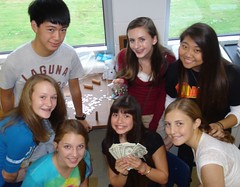
Money for Myrtles project up to $203.56 in donations; see more at cmh13.com
Originally uploaded by trudeau
Semester Projects: Social Studies Fair Team & Topic; Social Studies Book Choice
Please place in a GoogleDoc entitled Semester Projects the following -
a) Social Studies Fair Team & Topic:
- names of students working together on this project
- title, problem and hypothesis of SS Fair project
example:
* topic idea - Castles
* problem - How did castles develop into the turreted, tall stone structures that we know from Germany and England?
* hypothesis - Castles probably originated as primitive, simple and small structures and gradually evolved into the examples seen in 16th century Europe.
* research will be pursued in encyclopedias, books and online sites.
* conclusion - that castles originated in simple earthen walls around Roman army encampments and evolved into the motte-and-bailey design - which evolved into the castle that we see today.
b) Social Studies book -
* Title and author
* Brief summary
* Connection with European studies.
Deadline Fri, Oct 23.
a) Social Studies Fair Team & Topic:
- names of students working together on this project
- title, problem and hypothesis of SS Fair project
example:
* topic idea - Castles
* problem - How did castles develop into the turreted, tall stone structures that we know from Germany and England?
* hypothesis - Castles probably originated as primitive, simple and small structures and gradually evolved into the examples seen in 16th century Europe.
* research will be pursued in encyclopedias, books and online sites.
* conclusion - that castles originated in simple earthen walls around Roman army encampments and evolved into the motte-and-bailey design - which evolved into the castle that we see today.
b) Social Studies book -
* Title and author
* Brief summary
* Connection with European studies.
Deadline Fri, Oct 23.
Cmh13.com: another way to connect with your classmates
Thanks to Henry Lin for creating and maintaining cmh13.com. Check it, mes amis!
Monday, October 12, 2009
Mexico project Uno
Students will demonstrate knowledge of geography and technology in using Google Docs to assemble, store and present reports on Mexico to the following standards -
Topics -
1. Border cities: Tijuana, Ciudad Juarez,
2. Mountain cities: Guadalajara, Monterrey
3. The capital: Mexico City, Distrito Federale
4. Resorts: Acapulco & Mazatlan
5. Baja Sur and Cabo San Lucas
6. The Aztec and Montezuma
7. Cortez and the conquistadors
8. Yucatan Peninsula and Merida
9. Resorts: Cancun and Cozumel
10. Dia de los Muertos
Each report will have bulleted (very brief) info and images (slides) as follows
1. landscape
2. architecture (2), both of the lavish and the modest
3. people (2), young and elderly
4. transportation, mass transit and personal
5. foods and cooking (a crop & a dish)(2)
6. traditional clothing and fiestas (2)
7. Manufacturing for the US (and world) market - from guitars to cars (2)
8. Map of Mexico, featuring your locations
9.Documentation (sources) at bottom of each image
In the illustration above: almost every Mexican city has a an impressive Catholic church in the heart of downtown, usually built upon the site of the pre-Christian worship center.
Topics -
1. Border cities: Tijuana, Ciudad Juarez,
2. Mountain cities: Guadalajara, Monterrey
3. The capital: Mexico City, Distrito Federale
4. Resorts: Acapulco & Mazatlan
5. Baja Sur and Cabo San Lucas
6. The Aztec and Montezuma
7. Cortez and the conquistadors
8. Yucatan Peninsula and Merida
9. Resorts: Cancun and Cozumel
10. Dia de los Muertos
Each report will have bulleted (very brief) info and images (slides) as follows
1. landscape
2. architecture (2), both of the lavish and the modest
3. people (2), young and elderly
4. transportation, mass transit and personal
5. foods and cooking (a crop & a dish)(2)
6. traditional clothing and fiestas (2)
7. Manufacturing for the US (and world) market - from guitars to cars (2)
8. Map of Mexico, featuring your locations
9.Documentation (sources) at bottom of each image
In the illustration above: almost every Mexican city has a an impressive Catholic church in the heart of downtown, usually built upon the site of the pre-Christian worship center.
Saturday, October 10, 2009
Genealogy and America: the roots of Michelle LaVaughn Robinson Obama
Of Michelle Obama and the NY Times research, “She is representative of how we have evolved and who we are,” said Edward Ball, a historian who discovered that he had black relatives, the descendants of his white slave-owning ancestors, when he researched his memoir, “Slaves in the Family.”
“We are not separate tribes of Latinos and whites and blacks in America,” Mr. Ball said. “We’ve all mingled, and we have done so for generations.”
Continue reading here.
“We are not separate tribes of Latinos and whites and blacks in America,” Mr. Ball said. “We’ve all mingled, and we have done so for generations.”
Continue reading here.
Friday, October 09, 2009
Lungi: a man-skirt retained from the ancient days when all men wore skirts
One of the many things we learned from our special lecture by Magnet teacher Deborah Morehead was that Asian mean still wear skirts.
In Asian countries, it's perfectly acceptable for a man to switch between a three piece Western suit and a salwar-kameez, a robe or a lungi.
Nowadays, fashion conscious Asian men are adopting long flowing robes, jackets and dhotis or baggy kameezs and salwars, with a shawl thrown over the shoulder.
In Asian countries, it's perfectly acceptable for a man to switch between a three piece Western suit and a salwar-kameez, a robe or a lungi.
Nowadays, fashion conscious Asian men are adopting long flowing robes, jackets and dhotis or baggy kameezs and salwars, with a shawl thrown over the shoulder.
We measure things oddly; we look at feet and miles, the rest of the world uses metric
On the highway the metric system's outline is like this:
1 mile = 1.6 kilometers
30 miles = 48.2 kilometers
100 miles = 161 kilometers
For any sort of metric conversion, see this site.
1 mile = 1.6 kilometers
30 miles = 48.2 kilometers
100 miles = 161 kilometers
For any sort of metric conversion, see this site.
Thursday, October 08, 2009
Maple Leaf Quiz / Geography Open Notes review # 6
Maple Leaf Quiz / Geography Open notes review # 6
1. This city is the second-largest primarily French-speaking city in the world, after Paris: a) Montreal b) Toronto c) Vancouver d) Ottawa.
2. Because of the city's low crime rates, clean environment, high standard of living, and friendlier attitudes to diversity, _____ is consistently rated as one of the world's most livable cities by the Economist. a) Montreal b) Toronto c) Vancouver d) Ottawa.
3. It has become the third-largest film production centre in North America after Los Angeles and New York City, earning it the nickname Hollywood North.
a) Montreal b) Toronto c) Vancouver d) Ottawa.
4. Home to the world-renowned dance troupe Cirque du Soleil.
a) Montreal b) Toronto c) Vancouver d) Ottawa.
5. Jean-Baptiste Le Moyne, Sieur de Bienville and his brother Pierre Le Moyne, Sieur d'Iberville were born in a) London b) Paris c) Montreal d) New Orleans.
6. Acadians are French people who spent some 150 years living in the region of Canada called: a) Acadiana b) Arcadia c) Nova Scotia d) Quebec.
7. Canada’s population is about one tenth of the US population; the US is also slightly larger than Canada in area. T / F
8. Oklahoma is part of the American region called the: a) Midwest b) Southwest c) Northwest d) Southeast.
9. The Empire State Building was creamed by a B-25 bomber during the __ era.
a) WWI b) WWII c) Korean War d) Vietnam Conflict
10. Strawberry Fields is a location in both a) NYC & London b) Chicago & London
c) NYC & Liverpool d) Chicago & Montreal.
11. "OMG, my mother said I have to put my phone up." a) shillalagh
b) shibboleth c) shilly shally d) shilling.
1. This city is the second-largest primarily French-speaking city in the world, after Paris: a) Montreal b) Toronto c) Vancouver d) Ottawa.
2. Because of the city's low crime rates, clean environment, high standard of living, and friendlier attitudes to diversity, _____ is consistently rated as one of the world's most livable cities by the Economist. a) Montreal b) Toronto c) Vancouver d) Ottawa.
3. It has become the third-largest film production centre in North America after Los Angeles and New York City, earning it the nickname Hollywood North.
a) Montreal b) Toronto c) Vancouver d) Ottawa.
4. Home to the world-renowned dance troupe Cirque du Soleil.
a) Montreal b) Toronto c) Vancouver d) Ottawa.
5. Jean-Baptiste Le Moyne, Sieur de Bienville and his brother Pierre Le Moyne, Sieur d'Iberville were born in a) London b) Paris c) Montreal d) New Orleans.
6. Acadians are French people who spent some 150 years living in the region of Canada called: a) Acadiana b) Arcadia c) Nova Scotia d) Quebec.
7. Canada’s population is about one tenth of the US population; the US is also slightly larger than Canada in area. T / F
8. Oklahoma is part of the American region called the: a) Midwest b) Southwest c) Northwest d) Southeast.
9. The Empire State Building was creamed by a B-25 bomber during the __ era.
a) WWI b) WWII c) Korean War d) Vietnam Conflict
10. Strawberry Fields is a location in both a) NYC & London b) Chicago & London
c) NYC & Liverpool d) Chicago & Montreal.
11. "OMG, my mother said I have to put my phone up." a) shillalagh
b) shibboleth c) shilly shally d) shilling.
Mexico City profile from About.com
United Mexican States
Estados Unidos Mexicanos
President: Felipe Calderón (2006)
Land area: 742,485 sq mi
Population (2006 est.): 107,449,525 (growth rate: 1.2%); birth rate: 20.7/1000; infant mortality rate: 20.3/1000; life expectancy: 75.4; density per sq mi: 145
Capital and largest city (2003 est.): Mexico City, 19,013,000 (metro. area)
Other large cities: Guadalajara, 1,665,800; Puebla, 1,345,500; Monterrey, 1,135,000
Languages: Spanish, various Mayan, Nahuatl, and other regional indigenous languages
Ethnicity/race: mestizo (Amerindian-Spanish) 60%, Amerindian or predominantly Amerindian 30%, white 9%, other 1%
Religions: nominally Roman Catholic 89%, Protestant 6%, other 5%
Literacy rate: 92% (2003 est.)
Economic summary: GDP/PPP (2005 est.): $1.068 trillion; per capita $10,100. Real growth rate: 3%. Inflation: 3.3%. Unemployment: 3.6% plus underemployment of perhaps 25%. Arable land: 13%.
Agriculture: corn, wheat, soybeans, rice, beans, cotton, coffee, fruit, tomatoes; beef, poultry, dairy products; wood products.
Labor force: 43.4 million; agriculture 18%, industry 24%, services 58% (2003). Industries: food and beverages, tobacco, chemicals, iron and steel, petroleum, mining, textiles, clothing, motor vehicles, consumer durables, tourism.
Natural resources: petroleum, silver, copper, gold, lead, zinc, natural gas, timber. Exports: $213.7 billion f.o.b. (2005 est.): manufactured goods, oil and oil products, silver, fruits, vegetables, coffee, cotton.
Imports: $223.7 billion f.o.b. (2005 est.): metalworking machines, steel mill products, agricultural machinery, electrical equipment, car parts for assembly, repair parts for motor vehicles, aircraft, and aircraft parts.
Major trading partners: U.S., Canada, Spain, China, Japan (2004).
Communications: Telephones: main lines in use: 12.332 million (2000); mobile cellular: 2.02 million. Television broadcast stations: 236 (plus repeaters) (1997). Televisions: 25.6 million (1997).
Internet Service Providers (ISPs): 51 (2000). Internet users: 3.5 million (2002).
Transportation: Railways: total: 19,510 km (2002).
Highways: total: 329,532 km; paved: 108,087 km (including 6,429 km of expressways); unpaved: 221,445 km (1999 est.).
Waterways: 2,900 km navigable rivers and coastal canals.
Ports and harbors: Acapulco, Altamira, Coatzacoalcos, Ensenada, Guaymas, La Paz, Lazaro Cardenas, Manzanillo, Mazatlan, Progreso, Salina Cruz, Tampico, Topolobampo, Tuxpan, Veracruz.
Airports: 1,823 (2002)
Estados Unidos Mexicanos
President: Felipe Calderón (2006)
Land area: 742,485 sq mi
Population (2006 est.): 107,449,525 (growth rate: 1.2%); birth rate: 20.7/1000; infant mortality rate: 20.3/1000; life expectancy: 75.4; density per sq mi: 145
Capital and largest city (2003 est.): Mexico City, 19,013,000 (metro. area)
Other large cities: Guadalajara, 1,665,800; Puebla, 1,345,500; Monterrey, 1,135,000
Languages: Spanish, various Mayan, Nahuatl, and other regional indigenous languages
Ethnicity/race: mestizo (Amerindian-Spanish) 60%, Amerindian or predominantly Amerindian 30%, white 9%, other 1%
Religions: nominally Roman Catholic 89%, Protestant 6%, other 5%
Literacy rate: 92% (2003 est.)
Economic summary: GDP/PPP (2005 est.): $1.068 trillion; per capita $10,100. Real growth rate: 3%. Inflation: 3.3%. Unemployment: 3.6% plus underemployment of perhaps 25%. Arable land: 13%.
Agriculture: corn, wheat, soybeans, rice, beans, cotton, coffee, fruit, tomatoes; beef, poultry, dairy products; wood products.
Labor force: 43.4 million; agriculture 18%, industry 24%, services 58% (2003). Industries: food and beverages, tobacco, chemicals, iron and steel, petroleum, mining, textiles, clothing, motor vehicles, consumer durables, tourism.
Natural resources: petroleum, silver, copper, gold, lead, zinc, natural gas, timber. Exports: $213.7 billion f.o.b. (2005 est.): manufactured goods, oil and oil products, silver, fruits, vegetables, coffee, cotton.
Imports: $223.7 billion f.o.b. (2005 est.): metalworking machines, steel mill products, agricultural machinery, electrical equipment, car parts for assembly, repair parts for motor vehicles, aircraft, and aircraft parts.
Major trading partners: U.S., Canada, Spain, China, Japan (2004).
Communications: Telephones: main lines in use: 12.332 million (2000); mobile cellular: 2.02 million. Television broadcast stations: 236 (plus repeaters) (1997). Televisions: 25.6 million (1997).
Internet Service Providers (ISPs): 51 (2000). Internet users: 3.5 million (2002).
Transportation: Railways: total: 19,510 km (2002).
Highways: total: 329,532 km; paved: 108,087 km (including 6,429 km of expressways); unpaved: 221,445 km (1999 est.).
Waterways: 2,900 km navigable rivers and coastal canals.
Ports and harbors: Acapulco, Altamira, Coatzacoalcos, Ensenada, Guaymas, La Paz, Lazaro Cardenas, Manzanillo, Mazatlan, Progreso, Salina Cruz, Tampico, Topolobampo, Tuxpan, Veracruz.
Airports: 1,823 (2002)
The geography class Open Notes quiz is based on web site notes
Here's the recipe for success in this social studies class:
a) Your daily homework is to read the class blog. Your teacher updates it almost daily. He is presenting material he feels is important for your future.
b) Print out the class blog notes. If your home printer is not working, please print at the school library. It costs a bit of money, but it is a smart investment. Do you think it would be smart to have all those notes in a binder? I agree.
c) Read and highlight your notes at least once a week.
d) Practice your map work daily - as needed.
e) Look at the long-range projects:
- have you chosen a social studies fair project hypothesis and teammates?
- have you cleared a book title with your teacher for the book report due once each semester in enriched geography class?
a) Your daily homework is to read the class blog. Your teacher updates it almost daily. He is presenting material he feels is important for your future.
b) Print out the class blog notes. If your home printer is not working, please print at the school library. It costs a bit of money, but it is a smart investment. Do you think it would be smart to have all those notes in a binder? I agree.
c) Read and highlight your notes at least once a week.
d) Practice your map work daily - as needed.
e) Look at the long-range projects:
- have you chosen a social studies fair project hypothesis and teammates?
- have you cleared a book title with your teacher for the book report due once each semester in enriched geography class?
Dancing house Gecko
The House Gecko is also known as Hemidactylus, a genus of the family of typical geckos, Gekkonidae. It is the second-most[verification needed] speciose genus in the family, says Wikipedia, with about 90 described species, newfound ones being described every few years.
These geckos are found in all the tropical regions of the world, extending into the subtropical parts of Africa and Europe. They excel in colonizing oceanic islands by rafting on flotsam, and are for example found across most of Polynesia.
They are typically known as house geckos, due to their readyness to adapt to and coexist with humans.
Geckos are small to average sized lizards belonging to the family Gekkonidae, found in warm climates throughout the world. Geckos are unique among lizards in their vocalizations, making chirping sounds in social interactions with other geckos. The name stems from the Indonesian/Javanese word Tokek, inspired by the sound these animals make. The Malay word for gecko is cicak.
The House Gecko often becomes accepted as part of the indoor menagerie and are often welcome guests, as they feed on insects, including mosquitoes.
These geckos are found in all the tropical regions of the world, extending into the subtropical parts of Africa and Europe. They excel in colonizing oceanic islands by rafting on flotsam, and are for example found across most of Polynesia.
They are typically known as house geckos, due to their readyness to adapt to and coexist with humans.
Geckos are small to average sized lizards belonging to the family Gekkonidae, found in warm climates throughout the world. Geckos are unique among lizards in their vocalizations, making chirping sounds in social interactions with other geckos. The name stems from the Indonesian/Javanese word Tokek, inspired by the sound these animals make. The Malay word for gecko is cicak.
The House Gecko often becomes accepted as part of the indoor menagerie and are often welcome guests, as they feed on insects, including mosquitoes.
Wednesday, October 07, 2009
Salmon: global resource that is important to Canadians
Salmon live in both the Atlantic and Pacific Oceans, as well as the Great Lakes.
Typically, salmon are anadromous: they are born in fresh water, migrate to the ocean, then return to fresh water to reproduce.
Freshwater streams and estuaries provide important habitat for many salmon species. They feed on terrestrial and aquatic insects, amphipods, and other crustaceans while young, and primarily on other fish when older, says Wikipedia.
Salmon is a popular food. Classified as an "oily fish",[9] salmon is considered to be healthy due to the fish's high protein, high Omega-3 fatty acids, and high vitamin D[10] content. According to reports in the journal Science, however, farmed salmon may contain high levels of dioxins. PCB (polychlorinated biphenyl) levels may be up to eight times higher in farmed salmon than in wild salmon. Nonetheless, according to a 2006 study published in the Journal of the American Medical Association, the benefits of eating even farmed salmon still outweigh any risks imposed by contaminants.
The population of wild salmon declined markedly in recent decades, especially north Atlantic populations which spawn in the waters of western Europe and eastern Canada, and wild salmon in the Snake and Columbia River system in northwestern United States.
- Overfishing in general.
- Ocean and river warming.
Salmon aquaculture represents over $1 billion US annually. Other commonly cultured fish species include: tilapia, catfish, sea bass, carp, bream, and trout.
Salmon farming is very big in Chile, Norway, Scotland and Canada and is the source for most salmon consumed in America and Europe.
Typically, salmon are anadromous: they are born in fresh water, migrate to the ocean, then return to fresh water to reproduce.
Freshwater streams and estuaries provide important habitat for many salmon species. They feed on terrestrial and aquatic insects, amphipods, and other crustaceans while young, and primarily on other fish when older, says Wikipedia.
Salmon is a popular food. Classified as an "oily fish",[9] salmon is considered to be healthy due to the fish's high protein, high Omega-3 fatty acids, and high vitamin D[10] content. According to reports in the journal Science, however, farmed salmon may contain high levels of dioxins. PCB (polychlorinated biphenyl) levels may be up to eight times higher in farmed salmon than in wild salmon. Nonetheless, according to a 2006 study published in the Journal of the American Medical Association, the benefits of eating even farmed salmon still outweigh any risks imposed by contaminants.
The population of wild salmon declined markedly in recent decades, especially north Atlantic populations which spawn in the waters of western Europe and eastern Canada, and wild salmon in the Snake and Columbia River system in northwestern United States.
- Overfishing in general.
- Ocean and river warming.
Salmon aquaculture represents over $1 billion US annually. Other commonly cultured fish species include: tilapia, catfish, sea bass, carp, bream, and trout.
Salmon farming is very big in Chile, Norway, Scotland and Canada and is the source for most salmon consumed in America and Europe.
Tuesday, October 06, 2009
Vancouver to Quebec: a review of Canada
It's a quiz, eh!
1. Canada’s population is about one tenth of the US population, although it is slightly larger than the US in area. T / F
2. An island in Eastern Canada came under British rule with the Treaty of Utrecht (1713). This resulted in a serious change in the population of a) Nova Scotia b) Quebec c) Massachusetts
d) Montreal.
3. Canadians often speak 2 languages, owing to their nation’s ethnicity: a) English & German b) English & French c) English & Inuit d) English & Canadianne.
4. Born and raised in Montreal: a) Michael Cera
b) Sieur d’Iberville c) Beausoleil d) Celine Dion.
5. The French who were born in Louisiana colony were called a) Creoles b) Acadiennes c) Cajuns d) Gumbo.
6. Between their impoverished life in Western France and their impoverished life as pioneers in Louisiana, the French colonists spent about 150 years in a) the Caribbean b) British Columbia c) Toronto d) Acadia.
7. Guy Laliberté and Daniel Gauthier founded a) Canadian Waste Disposals Systems b) Cirque de Soleil c) the rock band Rush d) Quebec City.
8. The nation’s capital: a) Quebec b) Montreal c) Ottowa
d) Toronto.
9. The Great Lakes connect to the Atlantic via the
a) Illinois-Michigan Canal b) Erie Canal c) Niagra Falls
d) St Lawrence River.
10. Part of Canada is an archipelago. T / F
11. “Canada is also geologically active, having many earthquakes and potentially active volcanoes,” says Wikipedia. This would refer to __ Canada. a) Eastern b) Western c) Northern d) Southern
12. The coordinates are 45N, 73W: a) Toronto b) Winnipeg c) Detroit d) Montreal.
13. Land area: which is larger, the US or Canada?
1. Canada’s population is about one tenth of the US population, although it is slightly larger than the US in area. T / F
2. An island in Eastern Canada came under British rule with the Treaty of Utrecht (1713). This resulted in a serious change in the population of a) Nova Scotia b) Quebec c) Massachusetts
d) Montreal.
3. Canadians often speak 2 languages, owing to their nation’s ethnicity: a) English & German b) English & French c) English & Inuit d) English & Canadianne.
4. Born and raised in Montreal: a) Michael Cera
b) Sieur d’Iberville c) Beausoleil d) Celine Dion.
5. The French who were born in Louisiana colony were called a) Creoles b) Acadiennes c) Cajuns d) Gumbo.
6. Between their impoverished life in Western France and their impoverished life as pioneers in Louisiana, the French colonists spent about 150 years in a) the Caribbean b) British Columbia c) Toronto d) Acadia.
7. Guy Laliberté and Daniel Gauthier founded a) Canadian Waste Disposals Systems b) Cirque de Soleil c) the rock band Rush d) Quebec City.
8. The nation’s capital: a) Quebec b) Montreal c) Ottowa
d) Toronto.
9. The Great Lakes connect to the Atlantic via the
a) Illinois-Michigan Canal b) Erie Canal c) Niagra Falls
d) St Lawrence River.
10. Part of Canada is an archipelago. T / F
11. “Canada is also geologically active, having many earthquakes and potentially active volcanoes,” says Wikipedia. This would refer to __ Canada. a) Eastern b) Western c) Northern d) Southern
12. The coordinates are 45N, 73W: a) Toronto b) Winnipeg c) Detroit d) Montreal.
13. Land area: which is larger, the US or Canada?
Monday, October 05, 2009
Three cacophonous cities / geography quiz 5
Three cacophonous cities / geography quiz 5
Open notes . . . (students present on Oct 1 took this quiz)
1. Largest city in the American Midwest. a) Los Angeles b) NYC c) Chicago.
2. A neighborhood named for the Dutch city of Haarlem. a) Los Angeles b) NYC c) Chicago.
3. Al Capone & other gangsters ruled here in the 1920’s. a) Los Angeles b) NYC c) Chicago.
4. First settler was Jean Baptiste Pointe du Sable. a) Los Angeles b) NYC c) Chicago.
5. Founded in 1837, 2 years after Shreveport. a) Los Angeles b) NYC c) Chicago.
6. Juan Rogriguez Cabrillo was a founder. a) Los Angeles b) NYC c) Chicago.
7. Lincoln Park and Millenium Park. a) Los Angeles b) NYC c) Chicago.
8. Columbia University. a) Los Angeles b) NYC c) Chicago.
9. “Gotham.” a) Los Angeles b) NYC c) Chicago.
10. Second largest US city. a) Los Angeles b) NYC c) Chicago.
11. El Pueblo de Nuestra Señora la Reina . . . a) Los Angeles b) NYC c) Chicago.
Open notes . . . (students present on Oct 1 took this quiz)
1. Largest city in the American Midwest. a) Los Angeles b) NYC c) Chicago.
2. A neighborhood named for the Dutch city of Haarlem. a) Los Angeles b) NYC c) Chicago.
3. Al Capone & other gangsters ruled here in the 1920’s. a) Los Angeles b) NYC c) Chicago.
4. First settler was Jean Baptiste Pointe du Sable. a) Los Angeles b) NYC c) Chicago.
5. Founded in 1837, 2 years after Shreveport. a) Los Angeles b) NYC c) Chicago.
6. Juan Rogriguez Cabrillo was a founder. a) Los Angeles b) NYC c) Chicago.
7. Lincoln Park and Millenium Park. a) Los Angeles b) NYC c) Chicago.
8. Columbia University. a) Los Angeles b) NYC c) Chicago.
9. “Gotham.” a) Los Angeles b) NYC c) Chicago.
10. Second largest US city. a) Los Angeles b) NYC c) Chicago.
11. El Pueblo de Nuestra Señora la Reina . . . a) Los Angeles b) NYC c) Chicago.
Quiz on Th, Oct 8: map of Canada and open notes quiz on NYC and Canada
Th, Oct 8, be ready to demonstrate
a) your mental map of
- the vast land called Canada (5 Great Lakes, 5 additional items)
b) your careful reading of the web site notes related to NYC and to Canada. You will have 11 multiple-choice questions on an open notes quiz.
I've forgotten: how was the birth of B-ball related to Canada?
a) your mental map of
- the vast land called Canada (5 Great Lakes, 5 additional items)
b) your careful reading of the web site notes related to NYC and to Canada. You will have 11 multiple-choice questions on an open notes quiz.
I've forgotten: how was the birth of B-ball related to Canada?
Brief reports on GoogleDocs comparing one facet of Mexico and Canada
Teams of 2 students each will create a bulleted presentation that compares Canada, Mexico and the US. The presentations will be worked on in class on Mon and presented Tues, Wed and Thurs. 5 pts.
Please include these images -
Title image w bulleted info.
Map of Canada.
Relevant image of Canada with bulleted info.
Map of Mexico
Related image of Mexico w bulleted info.
Each person should have a copy of the project in their Google Docs.
Please include these images -
Title image w bulleted info.
Map of Canada.
Relevant image of Canada with bulleted info.
Map of Mexico
Related image of Mexico w bulleted info.
Each person should have a copy of the project in their Google Docs.
Sunday, October 04, 2009
Oct 5 / this week: Canada vs Mexico
To live through a study of Canada, essentially a boring nation, you've got to find some spice. That peppery edge will come from comparing Canada to Mexico, our other great neighbor on the continent of North America.
We shall use the chart employed in our recent US/Canada comparison -
1. The 3 most populous cities; rank & pop.
2. Land area (numbers rounded)
3. European nations that colonized.
4. Date of independence.
5. Type of government.
6. Languages.
7. Origin of name.
8. Earliest explorer.
9. Earliest European settlements.
10. National wealth: per capita income (PCI).
11. Principal industries (3 or 4).
12. Additional industries (4 more).
13. Status in regards petroleum.
14.Agricultural strengths.
15. Status in Minerals.
16. Principal ethnic groups.
Also enjoyable ways to compare -
a) cuisine
b) music
c) athletics
d) stereotypes
e) animals
f) movies, TV
g) arts & crafts
Indie work this week (up to 10 pts extra credit):
Research and compare - acc to comparison essay guidelines - any of the following -
* Cirque du Soleil and the Ballet Folklorico de Mexico
* Joni Mitchell and Carlos Santana
* Canadian and Mexican cuisine
Also available:
Powerpoint-type reports on the topics above worth up to 6 pts.
We shall use the chart employed in our recent US/Canada comparison -
1. The 3 most populous cities; rank & pop.
2. Land area (numbers rounded)
3. European nations that colonized.
4. Date of independence.
5. Type of government.
6. Languages.
7. Origin of name.
8. Earliest explorer.
9. Earliest European settlements.
10. National wealth: per capita income (PCI).
11. Principal industries (3 or 4).
12. Additional industries (4 more).
13. Status in regards petroleum.
14.Agricultural strengths.
15. Status in Minerals.
16. Principal ethnic groups.
Also enjoyable ways to compare -
a) cuisine
b) music
c) athletics
d) stereotypes
e) animals
f) movies, TV
g) arts & crafts
Indie work this week (up to 10 pts extra credit):
Research and compare - acc to comparison essay guidelines - any of the following -
* Cirque du Soleil and the Ballet Folklorico de Mexico
* Joni Mitchell and Carlos Santana
* Canadian and Mexican cuisine
Also available:
Powerpoint-type reports on the topics above worth up to 6 pts.
Friday, October 02, 2009
Vieux Montreal has been called Petit Paris
Montreal is the second-largest city in Canada, says Wikipedia.
The city takes its present name from Mont-Royal, the triple-peaked hill located in the heart of the city, whose name was also initially given to the island on which the city is located,[7][8] or Mont Réal.
It's the 2nd largest city in Canada (3.6 M) and 7th overall in Northern America.
In the city proper, the language most spoken at home is French by 56.9% of the population. Montreal is the second-largest primarily French-speaking city in the world, after Paris.
There is archaeological evidence of various nomadic native people occupying the island of Montreal for at least 2,000 years before the arrival of Europeans.[15] The St. Lawrence Iroquoians established the village of Hochelaga at the foot of Mount Royal.[16] The French explorer Jacques Cartier visited Hochelaga on October 2, 1535, claiming the St. Lawrence Valley for France.
Montreal industries include aerospace, electronic goods, pharmaceuticals, printed goods, software engineering, telecommunications, textile and apparel manufacturing, tobacco and transportation. The service sector is also strong and includes civil, mechanical and process engineering, finance, higher education, and research and development. In 2002, Montreal ranked as the 4th largest centre in North America in terms of aerospace jobs.[72]
Montreal is also a centre of film and television production. The headquarter of five studios of the Academy Award-winning documentary producer National Film Board of Canada are in the city, as well as the head offices of Telefilm Canada. Given its eclectic architecture and broad availability of film services and crew members, Montreal is a popular filming location for feature-length films, and sometimes stands in for European locations.
The video game industry is also booming in Montreal since 1997, coinciding with the opening of Ubisoft Montreal.
Another success story: the world-renowned dance troupe Cirque du Soleil.
The city takes its present name from Mont-Royal, the triple-peaked hill located in the heart of the city, whose name was also initially given to the island on which the city is located,[7][8] or Mont Réal.
It's the 2nd largest city in Canada (3.6 M) and 7th overall in Northern America.
In the city proper, the language most spoken at home is French by 56.9% of the population. Montreal is the second-largest primarily French-speaking city in the world, after Paris.
There is archaeological evidence of various nomadic native people occupying the island of Montreal for at least 2,000 years before the arrival of Europeans.[15] The St. Lawrence Iroquoians established the village of Hochelaga at the foot of Mount Royal.[16] The French explorer Jacques Cartier visited Hochelaga on October 2, 1535, claiming the St. Lawrence Valley for France.
Montreal industries include aerospace, electronic goods, pharmaceuticals, printed goods, software engineering, telecommunications, textile and apparel manufacturing, tobacco and transportation. The service sector is also strong and includes civil, mechanical and process engineering, finance, higher education, and research and development. In 2002, Montreal ranked as the 4th largest centre in North America in terms of aerospace jobs.[72]
Montreal is also a centre of film and television production. The headquarter of five studios of the Academy Award-winning documentary producer National Film Board of Canada are in the city, as well as the head offices of Telefilm Canada. Given its eclectic architecture and broad availability of film services and crew members, Montreal is a popular filming location for feature-length films, and sometimes stands in for European locations.
The video game industry is also booming in Montreal since 1997, coinciding with the opening of Ubisoft Montreal.
Another success story: the world-renowned dance troupe Cirque du Soleil.
Canada's most populous city: Toronto
Toronto is the most populous city in Canada, says Wikipedia.
It is located on the northwestern shore of Lake Ontario. With over 2.5 million residents, it is the fifth most populous municipality in North America.
Toronto is part of a densely populated region in Southern Ontario known as the Golden Horseshoe, which is home to 8.1 million residents and has approximately 25% of Canada's population.
As Canada's economic capital, Toronto is considered a global city[6] and is one of the top financial centres in the world.[7][8] Toronto's leading economic sectors include finance, business services, telecommunications, aerospace, transportation, media, arts, film, television production, publishing, software production, medical research, education, tourism and sports industries.[9][10] The Toronto Stock Exchange, the world's seventh largest, is headquartered in the city, along with a majority of Canada's corporations.
Toronto's population is cosmopolitan and international,[11] reflecting its role as an important destination for immigrants to Canada.[12] Toronto is one of the world's most diverse cities by percentage of non-native-born residents, as about 49% of the population were born outside of Canada.[11][12][13]
Because of the city's low crime rates, clean environment, high standard of living, and friendlier attitudes to diversity, Toronto is consistently rated as one of the world's most livable cities by the Economist Intelligence Unit[14] and the Mercer Quality of Living Survey.
It is located on the northwestern shore of Lake Ontario. With over 2.5 million residents, it is the fifth most populous municipality in North America.
Toronto is part of a densely populated region in Southern Ontario known as the Golden Horseshoe, which is home to 8.1 million residents and has approximately 25% of Canada's population.
As Canada's economic capital, Toronto is considered a global city[6] and is one of the top financial centres in the world.[7][8] Toronto's leading economic sectors include finance, business services, telecommunications, aerospace, transportation, media, arts, film, television production, publishing, software production, medical research, education, tourism and sports industries.[9][10] The Toronto Stock Exchange, the world's seventh largest, is headquartered in the city, along with a majority of Canada's corporations.
Toronto's population is cosmopolitan and international,[11] reflecting its role as an important destination for immigrants to Canada.[12] Toronto is one of the world's most diverse cities by percentage of non-native-born residents, as about 49% of the population were born outside of Canada.[11][12][13]
Because of the city's low crime rates, clean environment, high standard of living, and friendlier attitudes to diversity, Toronto is consistently rated as one of the world's most livable cities by the Economist Intelligence Unit[14] and the Mercer Quality of Living Survey.
The high-tech, Asian and diverse Canadian city on the Pacific: Vancouver
Vancouver (pronounced /vænˈkuːvər/) is a coastal city and major seaport located in the Lower Mainland of southwestern British Columbia, Canada, says Wikipedia.
Vancouver is named after Captain George Vancouver, a British explorer. The name Vancouver itself originates from the Dutch "van Coevorden", denoting somebody from (in Dutch: "van") Coevorden, an old city in The Netherlands.[3]
As of July 2009, the city's estimated population was 615,473 and that of the metropolitan area, 2,318,200.
Vancouver is ethnically diverse, with 52% of city residents having a first language other than English.[7][8]
Vancouver was first settled by Europeans in the 1860s as a result of immigration to the Colony of British Columbia caused by the Fraser and Cariboo Gold Rushes, though only a very few settled in what would become the city of Vancouver. The city's roots are based in logging and the founding of a large lumber mill, which gave birth to Gastown.
The Port of Vancouver became internationally significant as a node in the global trade network of the British Empire with the combined steamship and railway of the Canadian Pacific Railway shortening shipping times from the Orient to London.
Today its second largest industry, after forestry, is tourism, and it has become the third-largest film production centre in North America after Los Angeles and New York City, earning it the nickname Hollywood North.[12][13][14][15][16]
Vancouver has been ranked as one of the most livable cities in the world[17] and is a destination for many international conferences and events. The 2010 Winter Olympics and 2010 Winter Paralympics will be held in Vancouver and nearby Whistler, a mountain town 125 km north of the city.[18][19][20]
Vancouver is named after Captain George Vancouver, a British explorer. The name Vancouver itself originates from the Dutch "van Coevorden", denoting somebody from (in Dutch: "van") Coevorden, an old city in The Netherlands.[3]
As of July 2009, the city's estimated population was 615,473 and that of the metropolitan area, 2,318,200.
Vancouver is ethnically diverse, with 52% of city residents having a first language other than English.[7][8]
Vancouver was first settled by Europeans in the 1860s as a result of immigration to the Colony of British Columbia caused by the Fraser and Cariboo Gold Rushes, though only a very few settled in what would become the city of Vancouver. The city's roots are based in logging and the founding of a large lumber mill, which gave birth to Gastown.
The Port of Vancouver became internationally significant as a node in the global trade network of the British Empire with the combined steamship and railway of the Canadian Pacific Railway shortening shipping times from the Orient to London.
Today its second largest industry, after forestry, is tourism, and it has become the third-largest film production centre in North America after Los Angeles and New York City, earning it the nickname Hollywood North.[12][13][14][15][16]
Vancouver has been ranked as one of the most livable cities in the world[17] and is a destination for many international conferences and events. The 2010 Winter Olympics and 2010 Winter Paralympics will be held in Vancouver and nearby Whistler, a mountain town 125 km north of the city.[18][19][20]
Famous Canadians in New Orleans' French Quarter: Bienville Monument
Jean-Baptiste Le Moyne, Sieur de Bienville, French Governor of Louisiana and founder of New Orleans, b. in Montreal, Canada, 24 February, 1680; d. in Paris, 7 March, 1767.
His father, Charles le Moyne de Bienville, settled in Canada in 1640; his three brothers, Iberville, Serigny, and Chateauguay, likewise distinguished themselves in the early history of Louisiana.
In 1698-1699, Bienville accompanied his brother Pierre Le Moyne, Sieur d'Iberville, in an expedition dispatched from France to explore the territory near the mouth of the Mississippi. They founded a settlement at old Biloxi, where in 1700 Bienville become commandant, and, after d'Iberville's death in 1706, governor of the colony.(February 23, 1680 – March 7, 1767)
His father, Charles le Moyne de Bienville, settled in Canada in 1640; his three brothers, Iberville, Serigny, and Chateauguay, likewise distinguished themselves in the early history of Louisiana.
In 1698-1699, Bienville accompanied his brother Pierre Le Moyne, Sieur d'Iberville, in an expedition dispatched from France to explore the territory near the mouth of the Mississippi. They founded a settlement at old Biloxi, where in 1700 Bienville become commandant, and, after d'Iberville's death in 1706, governor of the colony.(February 23, 1680 – March 7, 1767)
Thursday, October 01, 2009
The simplified Regional US: what is the Midwest?
The Midwestern United States (in the U.S. generally referred to as the Midwest) is one of the four geographic regions within the United States of America that are officially recognized by the United States Census Bureau, says Wikipedia.
The region consists of twelve states in the central and inland northeastern US: Illinois, Indiana, Iowa, Kansas, Michigan, Minnesota, Missouri, Nebraska, North Dakota, Ohio, South Dakota, and Wisconsin.
Yes. You see that there's a discrepancy between the Census Bureau and this map. That's a traditional if minor controversy.
The region consists of twelve states in the central and inland northeastern US: Illinois, Indiana, Iowa, Kansas, Michigan, Minnesota, Missouri, Nebraska, North Dakota, Ohio, South Dakota, and Wisconsin.
Yes. You see that there's a discrepancy between the Census Bureau and this map. That's a traditional if minor controversy.
The Ethicist: a columnist answers questions about ethics in modern daily life
The Ethicist
Life's full of questions; he's got answers.
Randy Cohen writes "The Ethicist" column in The New York Times Magazine. If you'd like help with a moral dilemma you're facing at school, at home, or at work, send your question to: ethicist@nytimes.com or The Ethicist, The New York Times Magazine, 620 Eighth Avenue, 6th Floor, New York, NY 10018, and include a phone number.
September 21, 2009
Candid camera in an elevator?
For a research project, one of my fellow graduate students wanted to film people in a campus elevator without their knowledge or consent. I think this is an invasion of privacy. He thinks it's fine because the film is for educational purposes and would never be shown publicly. Who's right?
M.S., RHODE ISLAND
YOU ARE. Your classmate is obliged to seek permission from the elevator riders. Dalton Conley, chairman of the sociology department at New York University, says, "In all research endeavors, student projects included, informed consent is the ideal that should be strived for."
This is a prudent policy. Much harm has been done to unwitting research subjects. The danger may be less in the social sciences, but here, too, scholars must be honest with their subjects. And while there may be little privacy to violate in an elevator, given the frequent use of surveillance cameras, that does not eliminate this duty.
Conley says consent is not required when it is impossible to obtain and the expectation of privacy is low (filming a crowd at a baseball game, for example), or when the research is sufficiently important (studying prisoner-guard interactions, say) and deception is necessary to pursue it.
But that is not the case here. (Nor am I reassured by any vow to never show the research footage. Somehow YouTube and the like continue to acquire such material.)
Your classmate's professor should instruct his students not just in research methodology, but in the ethics that govern it.
Life's full of questions; he's got answers.
Randy Cohen writes "The Ethicist" column in The New York Times Magazine. If you'd like help with a moral dilemma you're facing at school, at home, or at work, send your question to: ethicist@nytimes.com or The Ethicist, The New York Times Magazine, 620 Eighth Avenue, 6th Floor, New York, NY 10018, and include a phone number.
September 21, 2009
Candid camera in an elevator?
For a research project, one of my fellow graduate students wanted to film people in a campus elevator without their knowledge or consent. I think this is an invasion of privacy. He thinks it's fine because the film is for educational purposes and would never be shown publicly. Who's right?
M.S., RHODE ISLAND
YOU ARE. Your classmate is obliged to seek permission from the elevator riders. Dalton Conley, chairman of the sociology department at New York University, says, "In all research endeavors, student projects included, informed consent is the ideal that should be strived for."
This is a prudent policy. Much harm has been done to unwitting research subjects. The danger may be less in the social sciences, but here, too, scholars must be honest with their subjects. And while there may be little privacy to violate in an elevator, given the frequent use of surveillance cameras, that does not eliminate this duty.
Conley says consent is not required when it is impossible to obtain and the expectation of privacy is low (filming a crowd at a baseball game, for example), or when the research is sufficiently important (studying prisoner-guard interactions, say) and deception is necessary to pursue it.
But that is not the case here. (Nor am I reassured by any vow to never show the research footage. Somehow YouTube and the like continue to acquire such material.)
Your classmate's professor should instruct his students not just in research methodology, but in the ethics that govern it.
Subscribe to:
Posts (Atom)
